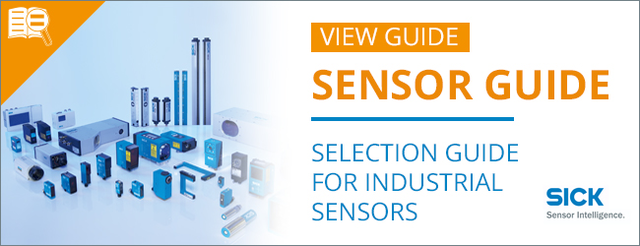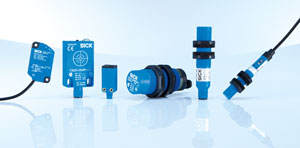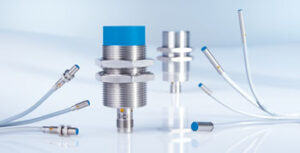Check out the guide below in order to learn more about commonly used sensors in industrial manufacturing today
Proximity Sensors
Capacitive proximity sensors
Capacitive proximity sensors detect all objects. The sensing range increases with the dielectric constant of the object to be detected. They are used in applications such as the following:
- Level monitoring when filling containers
- Level monitoring of bulk materials
- Final inspection in packaging processes
Inductive proximity sensors
Inductive proximity sensors offer reliable detection in nearly all areas and industry sectors. They detect metal targets and are suitable for diverse applications due to their variety of housing shapes and sizes. Applications include:
- Position sensing
- Transport monitoring
- Pulse generation
- RPM monitoring
- Detection of direction of rotation
- Feed and reject control
- Monitoring of idle running or congestion
Magnetic cylinder sensors
For many tasks in automation, it is necessary to precisely detect the position of pneumatic cylinders. SICK offers specially designed magnetic cylinder sensors for this purpose, which are used to determine the position of the pistons in pneumatic cylinders. They are mounted directly on the cylinder body. They reliably detect a magnet in the piston through the housing wall of aluminum, brass, 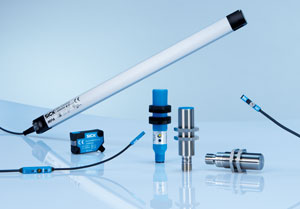 or stainless steel, and trigger a switching signal. As a result, the magnetic cylinder sensors from SICK feature high sensitivity and switching precision, in addition to practical mounting accessories for all commonly used pneumatic cylinders.
or stainless steel, and trigger a switching signal. As a result, the magnetic cylinder sensors from SICK feature high sensitivity and switching precision, in addition to practical mounting accessories for all commonly used pneumatic cylinders.
Magnetic proximity sensors
The defining feature of magnetic proximity sensors is their long sensing ranges, even with small housing sizes. They detect magnetic objects, usually permanent magnets, which are used to trigger switching. As magnetic fields can penetrate many non-magnetizable materials, switching can be triggered even through other materials. By using magnetic conductors (such as iron) the magnetic field can also be transported relatively long distances for various tasks, such as to take the signal out of an area of high temperature. The range of possible applications is correspondingly diverse, including:
- Object detection through plastic containers/tubes
- Object detection in aggressive media through a protective PTFE wall
- Detection of coding using magnets
- Object detection in high temperature zones
Photoelectric Sensors
Photoelectric proximity sensor, energetic
The most affordable photoelectric solution is the energetic proximity sensor. It features a light colored surface which reflects more light than a dark one would. It can therefore be detected from a greater distance away. To achieve similar results with a dark surface, the sensitivity of the sensor must be increased. However, detecting a dark object against a light background is not without its problems for energetic sensors. The object is obscured by glare from the background due to the higher reflectivity of the background. Overall, light colored objects against dark backgrounds are easier to detect.
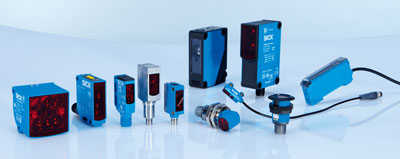
Photoelectric proximity sensor with background suppression, BGS
Photoelectric proximity sensors with background suppression (BGS) operate on the basis of the triangulation between the sender and receiving element. Signals from objects that are behind the set sensing range are suppressed. Sensors with SICK’s advanced BGS technology will ignore highly reflective objects in the background and therefore be immune to ambient lighting.
Photoelectric proximity sensor with foreground suppression, FGS
Photoelectric proximity sensors with foreground suppression (FGS) are able to detect objects at a defined sensing distance. All objects between the sensing distance (set to the background) and the sensor are detected. In order to maintain reliable functioning of these sensors, the background (for example, a conveyor belt) needs to be relatively bright and should not vary in height.
Photoelectric retro-reflective sensors
With a photoelectric retro-reflective sensor, the emitted light is returned by a reflector and is then received and evaluated by the sensor. Polarizing filters prevent errors when detecting reflective objects. Transparent plastic wrapping and stretch film can affect the functioning of photoelectric retro-reflective sensors. In such cases, it helps to use devices with reduced sensitivity. The use of lasers allows greater sensing ranges while simultaneously maintaining a high resolution. Focus ranges can be set with high precision.
Photoelectric retro-reflective sensors for detecting transparent objects
These photoelectric retro-reflective sensors are characterized by an especially low switching hysteresis. Even minimal light attenuation between the sensor and reflector — that would be caused by glass bottles or even PET bottles — is detected reliably.
In sensors with AutoAdapt, an innovative system monitoring feature continuously regulates and adapts the switching threshold in the event of gradual contamination that would otherwise lead to failure.
Through-beam photoelectric sensors
The through-beam photoelectric sensor consists of two devices, a sender and a receiver. The separation makes long sensing ranges possible. The use of laser diodes allows greater sensing ranges while simultaneously maintaining a high resolution. As a result, focus ranges can be set with high precision.
Photoelectric proximity sensor for Zone Control
Specially designed for material handling, photoelectric proximity sensors detect product on conveyors without contact. The detection signal is then evaluated in the logic unit and actuated via the valve of the electro-pneumatic cylinder. Overall, this technique allows the principle of accumulating conveying to be realized without the use of additional control elements.
Fiber-optic photoelectric sensors
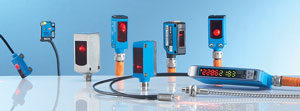 With fiber-optic photoelectric sensors, the sender and receiver are contained in a single housing. For use as a through-beam system, separate fiber-optic cables are used for the sender and the receiver. For a proximity system, the sender and receiver fiber-optic cables are joined in one fiber-optic cable. Fiber optic sensors can be used in many environments including hazardous and harsh environments, and in high temperature applications.
With fiber-optic photoelectric sensors, the sender and receiver are contained in a single housing. For use as a through-beam system, separate fiber-optic cables are used for the sender and the receiver. For a proximity system, the sender and receiver fiber-optic cables are joined in one fiber-optic cable. Fiber optic sensors can be used in many environments including hazardous and harsh environments, and in high temperature applications.
Connectivity Solutions
The M8 and M12 standard cables are produced by SICK and they provide multiple options for connecting your industrial automation processes. With PVC, PP, PUR, and field wireable cable connectors, these can be used in a variety of applications and are also able to withstand harsh industrial environments.
Download the full guide in order to learn more about choosing the right industrial sensor for your application:



